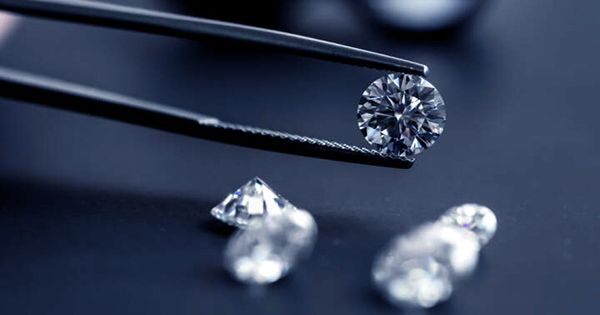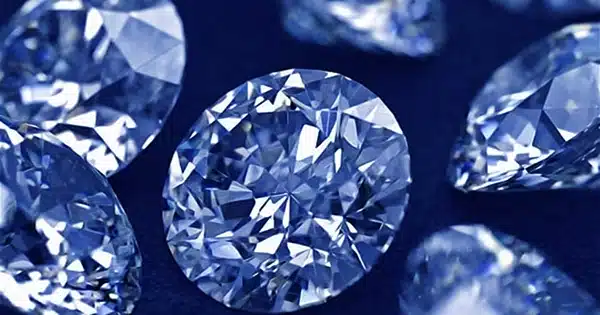In the beginning, he moved diamonds within his business, which was located in Surat, western India, the center of the world’s diamond polishing industry.
However, he gained experience inspecting diamonds over time, and today, he uses specialized tools to assess the quality of the stones.
The diamond industry has undergone a seismic shift that has completely changed his livelihood. All of the diamonds he examined up until two years ago were natural; they were taken from the earth at diamond mines.
He now works with diamonds produced by specialized machinery, a branch of an industry that, due to advances in technology, has experienced explosive growth in the past ten years.
Even professionals have to look carefully to distinguish lab-grown diamonds (LGDs) from natural diamonds.
According to Mr. Suhagiya, it is impossible to distinguish between native and lab-grown diamonds with the human eye.

“Natural diamonds and lab-grown diamonds are so close that there have occasionally been confusion regarding a diamond’s origin, even after a lab test. To confirm that the diamond was produced in a lab, it had to undergo two tests.
Natural diamonds are formed at great heat and pressure deep underground and, since the 1950s, scientists have been trying to recreate that process above ground – resulting in two techniques.
The High Pressure High Temperature (HPHT) system exposes a diamond seed to temperatures of about 1,500C and pressures of about 1.5 million pounds per square inch in a chamber while surrounding it with pure graphite (a form of carbon).
The seed is placed in a sealed chamber that is filled with a gas rich in carbon and heated to about 800C for the second procedure, known as Chemical Vapour Deposition (CVD). By adhering to the seed, the vapor creates a diamond atom by atom.
Although these methods were developed in the late 20th century, it has only been in the last ten years that they have been improved upon to the point where lab-grown diamonds can now be produced at the proper cost and quality to be sold as jewelry.
The rise of the lab-grown diamond: The first seven years saw a really big growth, according to Olya Linde, a partner with Bain and Company’s Natural Resources practice based in Zurich. “In the beginning, it was harder because there were very few machines and very few scientists able to do it,” she says.
Every four years, according to Ms. Linde, the expense of producing lab-grown diamonds has decreased by half.
Today, a lab-created one carat diamond, which is a popular size and frequently found in engagement bands, would cost about 20% less than a comparable naturally-formed stone.
The decreasing prices have drawn businesspeople.
Bhanderi Lab Grown Diamonds, which he founded in 2013, is led by Snehal Dungarni, who also serves as its CEO. Diamonds are created using the CVD method.
“At the highest level of purity, we are able to watch the diamond develop atom by atom.
According to him, they are “humane and environmentally kind” because they save on mining and extraction expenses and are, in comparison, cost- and time-effective.
Nine out of ten of the world’s diamonds are thought to be polished in Surat, making India a major player in the diamond business.
The government now wants India to play a significant role in the lab-grown gem industry.
According to the Ministry of Commerce and Industry, the country already produces about three million lab-grown diamonds annually, making up 15% of the world’s total output. The other major producer, China, has a comparable market percentage.
In an attempt to further stimulate the industry, the Indian government announced funding in January along with the elimination of a 5% tax on imported diamond seeds.
Diamond demand will rise as worldwide prosperity rises, predicts Vipul Bansal, joint secretary at the Ministry of Commerce.
Hari Krishna Exports is India’s top producer of cut and polished diamonds and has 30 years of experience in the traditional diamond business.
However, CEO Ghanshyambhai Dholakia started a lab-grown diamond company this year.
He forecasts that there will be a significant increase in demand for lab-created diamonds over the next three to four years.
But will his old diamond company lose customers to the new venture?
“Diamonds, both natural and created in a factory, appeal to various consumer groups. And desire exists in both segments,” says Mr Dholakia.
He claims that the middle class in India, who have money and can buy a lab-grown diamond, is a new consumer market that has been made possible by LGD.
However, it might take some time for that industry in India to grow. The United States imports the majority of Indian LGDs.
“Since the Indian market is still not ready for LGDs, the council is pushing exhibitions and events. According to Shashikant Dalichand Shah, head of the Lab Grown Diamond and Jewellery Promotion Council, India will be prepared in three to four years.
Mr. Shah is the CEO of Nine Diam, a gem trading business that his great-grandfather started.
He concurs that synthetic diamonds will occupy a very distinct position on the market than natural diamonds.
“A lab-created or factory-made diamond is a fake diamond. An informed and passionate customer will always choose a genuine diamond, the expert claims.
He continues by saying that because natural diamonds are more rare, their worth will last longer.
In contrast to natural diamonds, which maintain 50% of their value after purchase, lab-grown diamonds lose value after purchase, the expert claims.
Even though that might be the case, lab-grown diamonds give jewelry makers more creative freedom.
The diamond content of a natural stone should always be maximized because natural diamonds are so costly. You can create lab-grown diamonds however you like, according to Ms. Linde.
We’ve seen jewelry where the diamonds have been pierced to dangle and shine more.
The largest jeweler in the world, Pandora of Denmark, is converting to lab-grown diamonds. The company’s chief executive explained the decision in 2021, claiming it would expand the market for diamonds and make his firm more environmentally friendly.
Chintan Suhagiya, who is now back in Surat, is content with his decision to enter the LGD business and believes that many more people will find employment there.
“Millions of people are likely to find work in the lab-diamond industry. This business won’t be able to be stopped, he predicts.
















